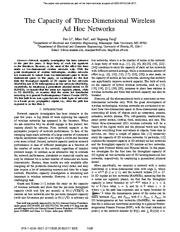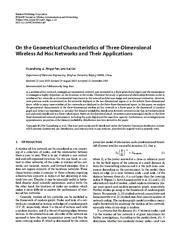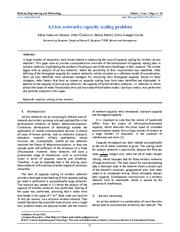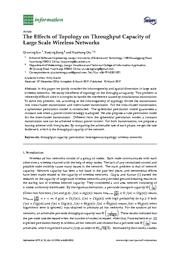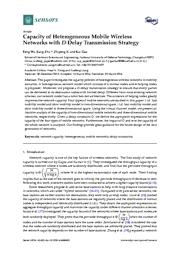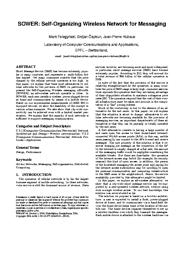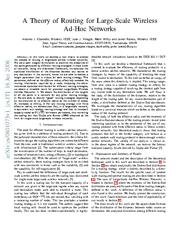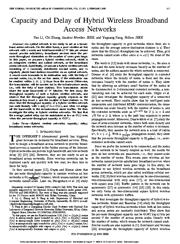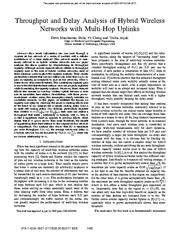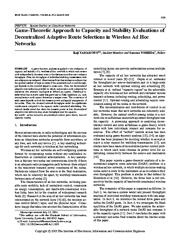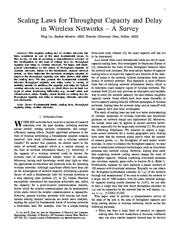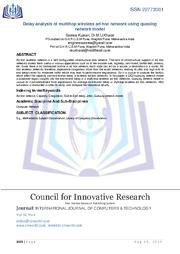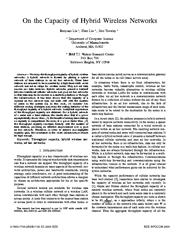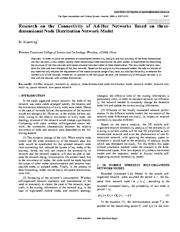A copy of this work was available on the public web and has been preserved in the Wayback Machine. The capture dates from 2018; you can also visit the original URL.
The file type is application/pdf.
Filters
The capacity of three-dimensional wireless ad hoc networks
2011
2011 Proceedings IEEE INFOCOM
In this paper, we investigate for the first time the throughput capacity of 3D regular ad hoc networks (RANETs) and of 3D heterogeneous ad hoc networks (HANETs), respectively, by employing a generalized ...
However, so far most of the effort has been made on two-dimensional wireless networks only. ...
CAPACITY OF THREE-DIMENSIONAL HETEROGENEOUS AD HOC NETWORKS In this section, we explore the capacity of three-dimensional heterogeneous ad hoc networks (HANETs), where the distribution of the nodes follows ...
doi:10.1109/infcom.2011.5934937
dblp:conf/infocom/LiPF11
fatcat:5sznetdowbgivpbcimdarc3keq
On the Geometrical Characteristics of Three-Dimensional Wireless Ad Hoc Networks and Their Applications
2006
EURASIP Journal on Wireless Communications and Networking
In this paper, we analyze the geometrical characteristics of the three-dimensional wireless ad hoc network in a finite space in the framework of random graph and deduce an expression to calculate the distance ...
However, most previous works concentrated on the networks deployed in the two-dimensional region or in the infinite three-dimensional space, while in many cases wireless ad hoc networks are deployed in ...
For a wireless ad hoc network in the finite two-dimensional region, we presented, in [5] , that the probability distribution of node degree is much more Figure 2 : Illustration for the three-dimensional ...
doi:10.1155/wcn/2006/31467
fatcat:7hyklksgnrd4vmcmbke7il6mei
Ad hoc networks capacity scaling problem
2021
Science, Engineering and Technology
A large number of researchers found their interest in addressing the issue of capacity scaling for wireless ad hoc networks. ...
Finally, the capacity of hybrid wireless networks, ie networks in which at least two types of nodes functionally exist (ad hoc nodes/infrastructure nodes / auxiliary nodes), was partially investigated. ...
(3) : ( ) = Θ (3) This is the case if the nodes are located on the surface of a three-dimensional sphere or the surface of a flat disk. ...
doi:10.54327/set2021/v1.i1.1
fatcat:h4ynqqi6rjh6tofjt62ziihxw4
The Effects of Topology on Throughput Capacity of Large Scale Wireless Networks
2017
Information
For the large scale three-dimensional wireless network, Gupta and Kumar [17] derived the transport capacity of three-dimensional arbitrary ad hoc networks and the throughput capacity of three-dimensional ...
In this paper, we explore the achievable throughput capacity of three-dimensional heterogeneous wireless ad hoc networks via percolation theory [20, 21] . ...
Xiaohong Qiu assisted in revising the paper. All authors have read and approved the final manuscript.
Conflicts of Interest: The authors declare no conflict of interest. ...
doi:10.3390/info8010032
fatcat:jv2upze775ed5hdksgv5qxbh64
Capacity of Heterogeneous Mobile Wireless Networks with D-Delay Transmission Strategy
2016
Sensors
Using the virtual channel model, we present an intuitive analysis of the capacity of two-dimensional mobile networks and three-dimensional mobile networks, respectively. ...
In fact, as wireless technologies are rapidly developing, wireless networks are extending from two-dimensional to three-dimensional space. ...
Acknowledgments: The work is supported by NUDT Science Foundation (No. ZDYYJCYJ20140701) and National Natural Science Foundation (No. 61401476 and No. 61201166). ...
doi:10.3390/s16040425
pmid:27023548
pmcid:PMC4850939
fatcat:s3wuhfajprhcdixpeui5r7aqwu
We explain that the capacity of such networks is sufficient to support messaging communication. ...
In particular, we present the Self-Organizing Wireless messaging nEtwoRk (SOWER), an all-wireless network operable in cities. ...
ACKNOWLEDGEMENTS The work presented in this paper was supported (in part) by the National Competence Center in Research on Mobile Information and Communication Systems (NCCR-MICS), a center supported by ...
doi:10.1145/1024733.1024735
dblp:conf/wmash/FelegyhaziCH04
fatcat:z53hrw6sk5dnzdc4tx3oujy66m
A Theory of Routing for Large-Scale Wireless Ad-Hoc Networks
[article]
2006
arXiv
pre-print
In this work we develop a new theory to analyse the process of routing in large-scale ad-hoc wireless networks. ...
Analysing the aforementioned statistical distribution for different routing strategies, we obtain a threefold result for practical Large-Scale Wireless Ad-Hoc Networks: 1) We obtain the distribution of ...
Network Model The network model that we will use is summarized graphically in Figure 1 . The nodes of a wireless ad-hoc network are randomly distributed in a three-dimensional space. ...
arXiv:cs/0601073v1
fatcat:jy2eph3cqzcbxap4sbefvdili4
Capacity and delay of hybrid wireless broadband access networks
2009
IEEE Journal on Selected Areas in Communications
On the other hand, a pure wireless ad hoc network with n nodes and total bandwidth of W bits per second cannot provide satisfactory broadband services since the pernode throughput diminishes as the number ...
We first study the throughput capacity of such a hybrid wireless network, and observe that the throughput capacity greatly depends on the maximum hop count L and the number of base stations m. ...
But, the throughput capacity of hybrid wireless networks is greater than that of pure ad hoc networks. ...
doi:10.1109/jsac.2009.090203
fatcat:qhj6l3etkfdq3kk5klufaitvnq
Throughput and delay analysis of hybrid wireless networks with multi-hop uplinks
2011
2011 Proceedings IEEE INFOCOM
How much information can one send through a random ad hoc network of nodes, if overlaid with a cellular architecture of base stations? ...
Although several research efforts related to throughput capacity exist in the area of hybrid wireless networks, most of these solutions under-explore the capacity analysis. ...
WORKS and = DELAY OF RELATED WORKS DELAY OF OUR DESIGN .
1) Comparison with Pure Ad Hoc Wireless Networks: In [2] , Gupta et.al studied the capacity of pure ad hoc wireless networks as grows to a large ...
doi:10.1109/infcom.2011.5934936
dblp:conf/infocom/ShilaCA11
fatcat:jlb3mrcbdvhnhfedmoybbsosfm
Game-Theoretic Approach to Capacity and Stability Evaluations of Decentralized Adaptive Route Selections in Wireless Ad Hoc Networks
2005
IEICE transactions on communications
A game-theoretic analysis is applied to the evaluation of capacity and stability of a wireless ad hoc network in which each source node independently chooses a route to the destination node so as to enhance ...
Then, the obtained network throughput under the equilibrium conditions is compared to the capacity under centralized scheduling. ...
A key enabling technology for such networks is wireless ad hoc networking. ...
doi:10.1093/ietcom/e88-b.3.1009
fatcat:uigfvjeavnf6vfda7ze6tmtvam
Scaling Laws for Throughput Capacity and Delay in Wireless Networks — A Survey
2014
IEEE Communications Surveys and Tutorials
The capacity scaling law of wireless networks has been considered as one of the most fundamental issues. ...
In this survey, we aim at providing a comprehensive overview of the development in the area of scaling laws for throughput capacity and delay in wireless networks. ...
ACKNOWLEDGEMENT The authors wish to thank Xiugang Wu from University of Waterloo for helpful discussions. ...
doi:10.1109/surv.2013.081313.00039
fatcat:7zfx4ympyveilmhacbkxo5z6fa
Delay analysis of multihop wireless ad hoc network using queuing network model
2011
INTERNATIONAL JOURNAL OF COMPUTERS & TECHNOLOGY
So it is crucial to analyze the factors which affect the capacity and end-to-end delay in wireless ad-hoc networks. ...
The lack of infrastructure support in ad hoc networks makes them useful in various applications such as at the disaster site, highway, vast forest, battle field, oceans, etc. ...
LITERARY SURVEY Previous work on the capacity of wireless ad hoc networks is found in [2] , [6] , [7] , [11] , [12] , and [14] - [17] . ...
doi:10.24297/ijct.v10i4.3250
fatcat:7nuki4ughfbwtbcx4gzw7dnine
Ad Hoc Networking With Cost-Effective Infrastructure: Generalized Capacity Scaling
[article]
2014
arXiv
pre-print
Capacity scaling of a large hybrid network with unit node density, consisting of n wireless ad hoc nodes, base stations (BSs) equipped with multiple antennas, and one remote central processor (RCP), is ...
and two infrastructure-supported routing protocols, and moreover, three-dimensional information-theoretic operating regimes are explicitly identified according to the three scaling parameters. ...
Then, all wireless ad hoc nodes on the left half of the network are S L 1 , while all ad hoc nodes on the right half and all BS antennas in the network are destinations D L 1 (see Fig. 10(a) ). ...
arXiv:1402.2042v2
fatcat:2npzlxp7prahjcywtzoi54szsy
On the capacity of hybrid wireless networks
2003
IEEE INFOCOM 2003. Twenty-second Annual Joint Conference of the IEEE Computer and Communications Societies (IEEE Cat. No.03CH37428)
We study the throughput capacity of hybrid wireless networks. A hybrid network is formed by placing a sparse network of base stations in an ad hoc network. ...
It has been shown that the capacity of a random ad hoc network does not scale well with the number of nodes in the system [1]. ...
In [4] , Gupta and Kumar studied the capacity of a random three-dimensional wireless ad hoc network, and showed that the aggregate throughput scales as Θ n log n 2 3 W . ...
doi:10.1109/infcom.2003.1208989
dblp:conf/infocom/LiuLT03
fatcat:x6jbz77l2bgu7p7hosrjjc7zfq
Research on the Connectivity of Ad-Hoc Networks Based on threedimensional Node Distribution Network Model
2014
Open Automation and Control Systems Journal
for describing the structure of Ad-Hoc network and communication between nodes in three-dimensional. ...
In order to solve the problems in complicated connectivity analysis and low accuracy of the three-dimensional Ad-Hoc network, a new model, namely three-dimensional node distribution network model, is established ...
However, in the mobile Ad-hoc network, owing to the relative movement of every node, the topology structure of the network would change significantly. ...
doi:10.2174/1874444301406011317
fatcat:kwsajcyfvvafti6hfw4elqmvnu
« Previous
Showing results 1 — 15 out of 9,455 results

